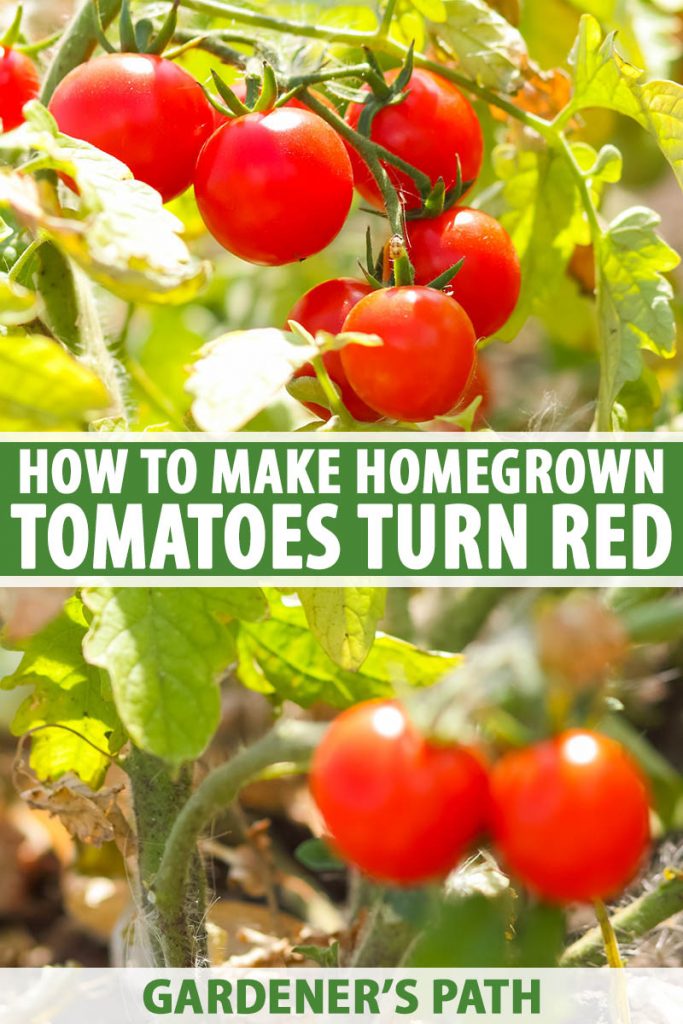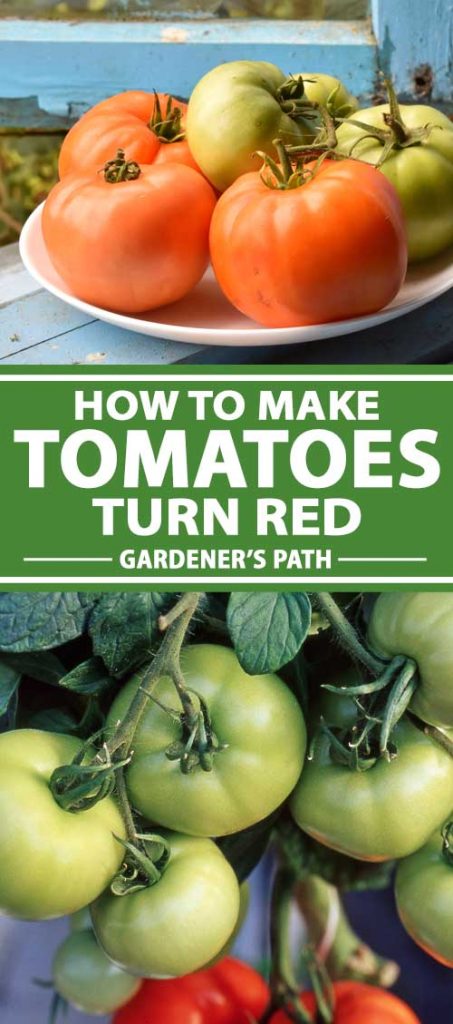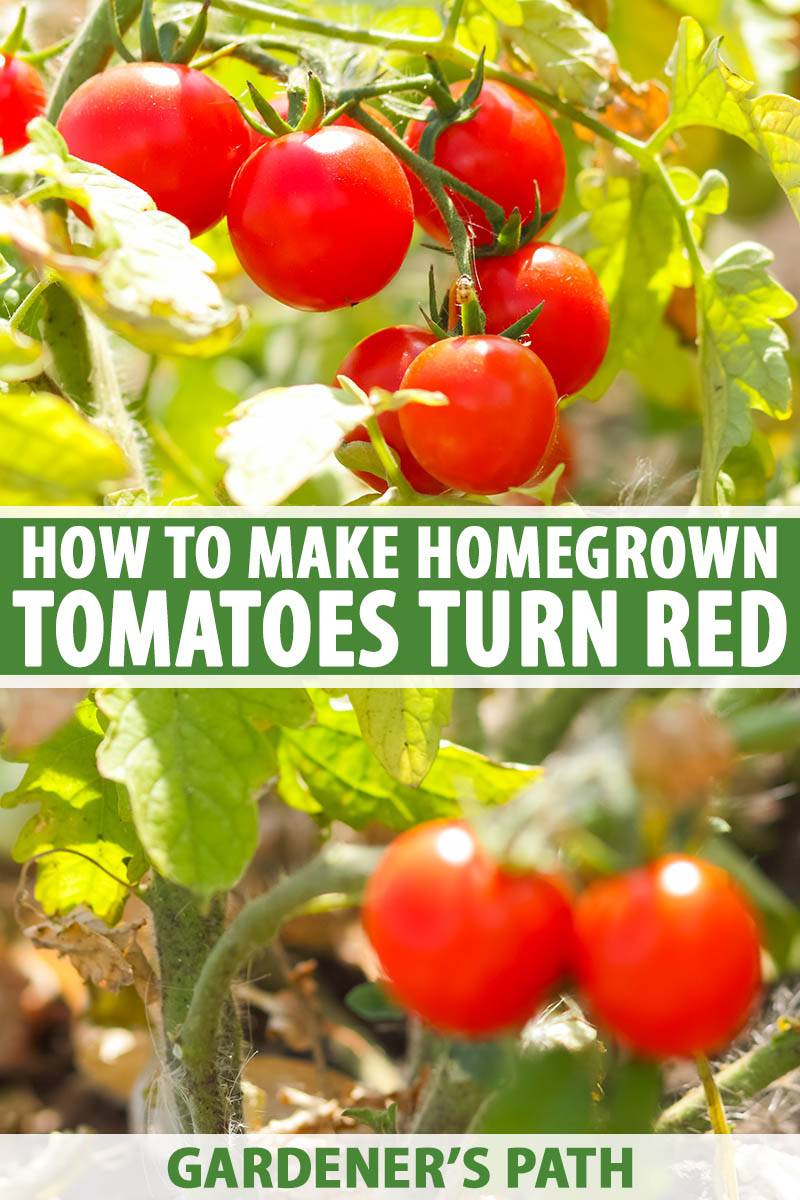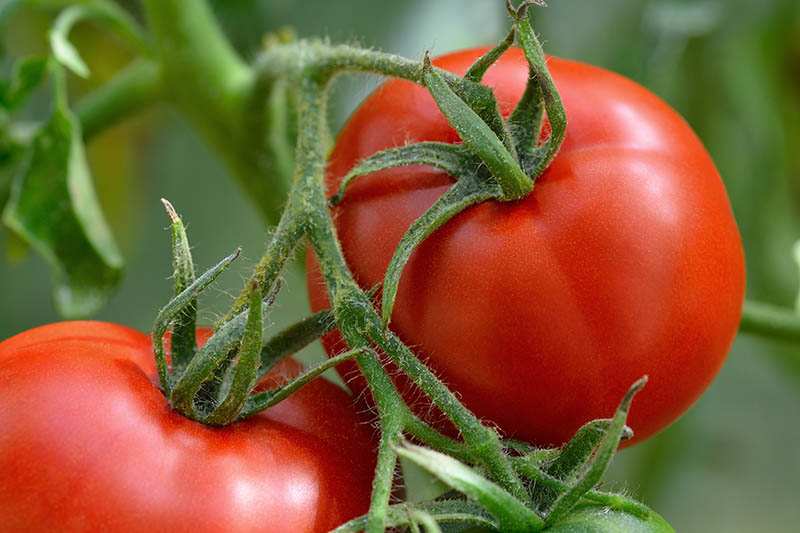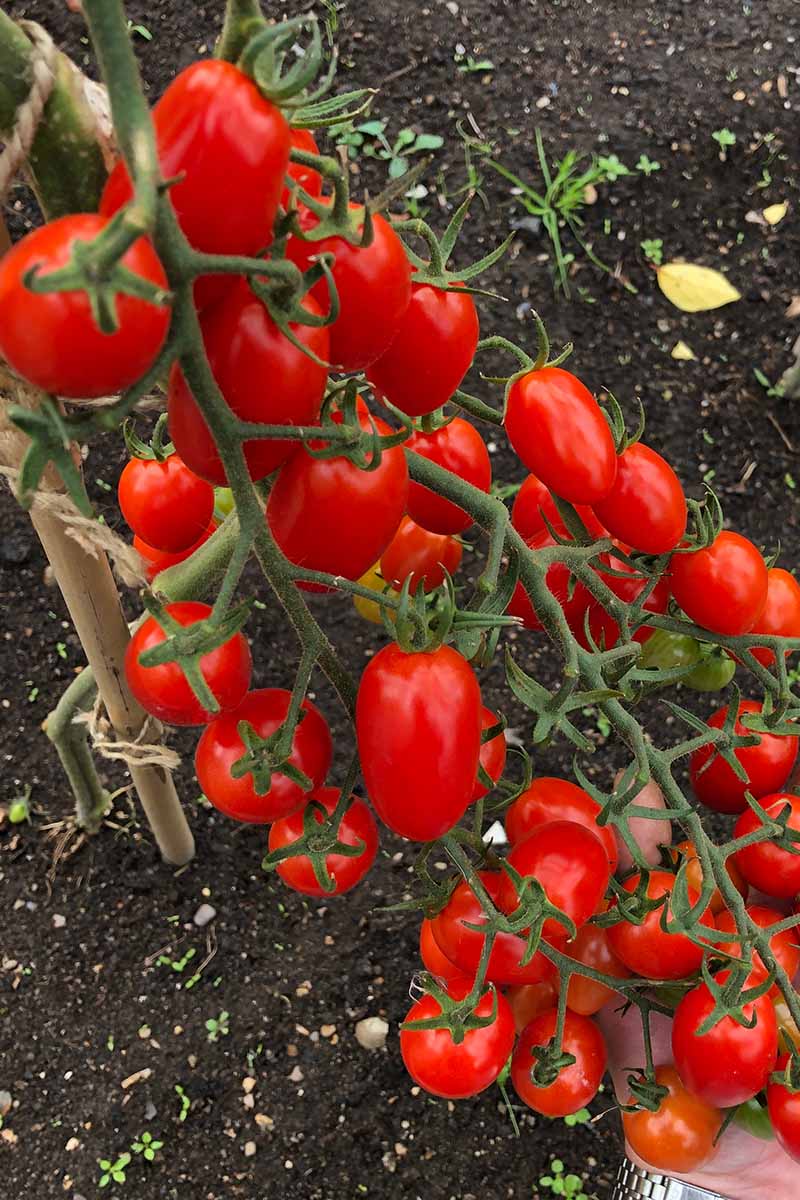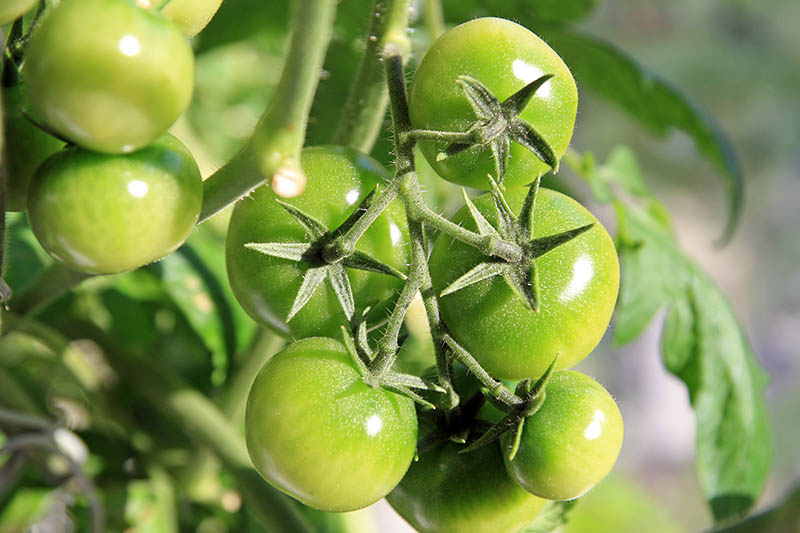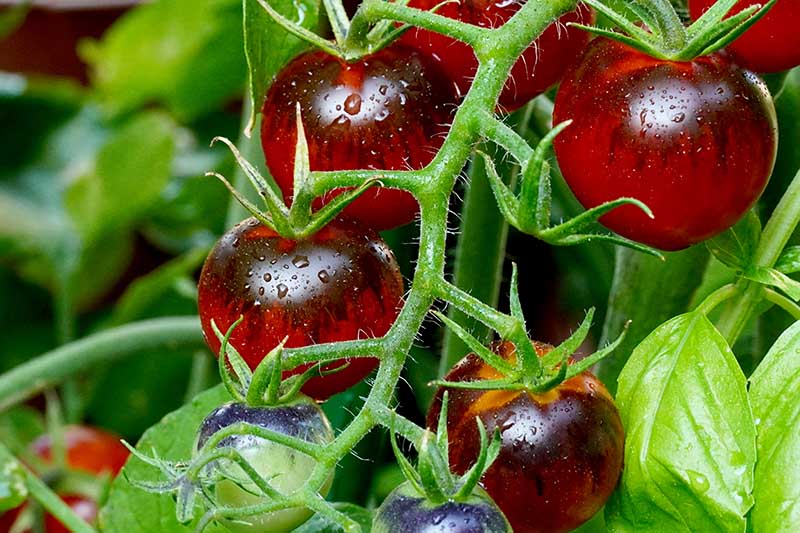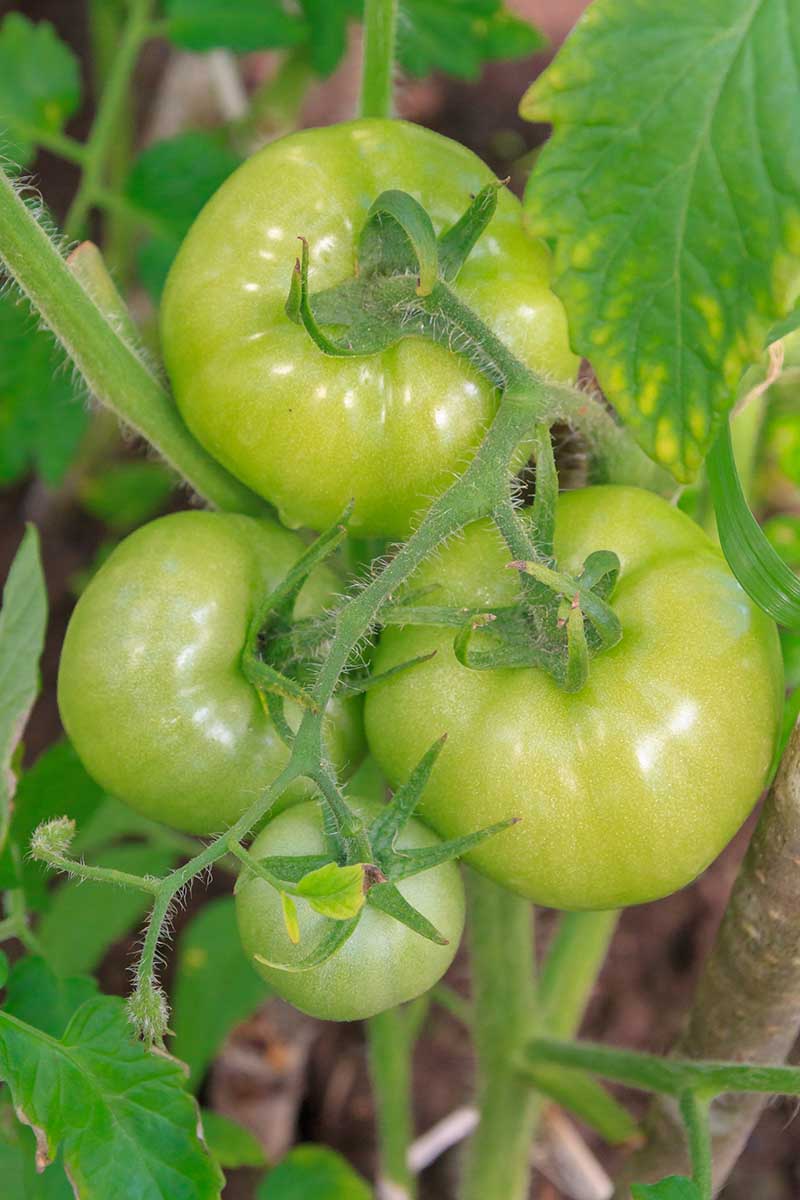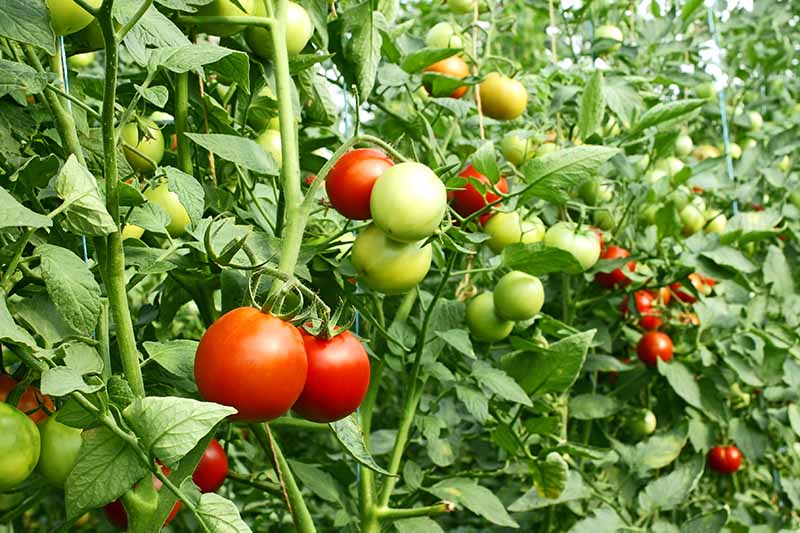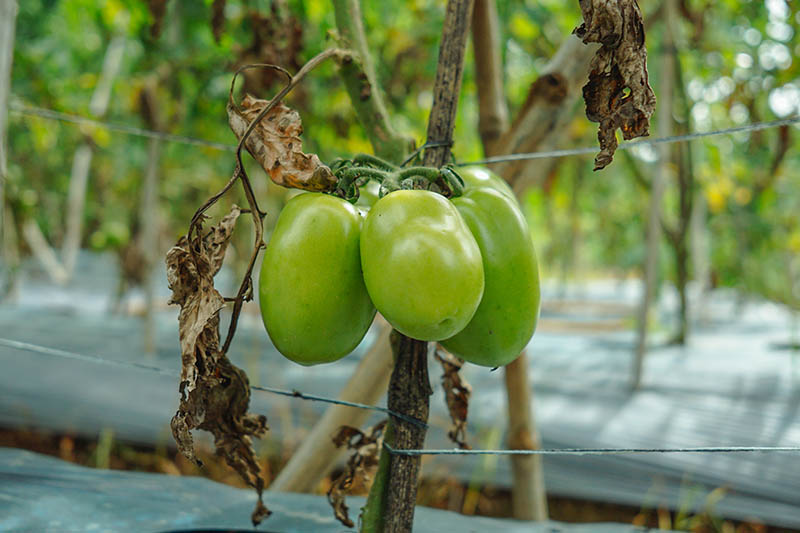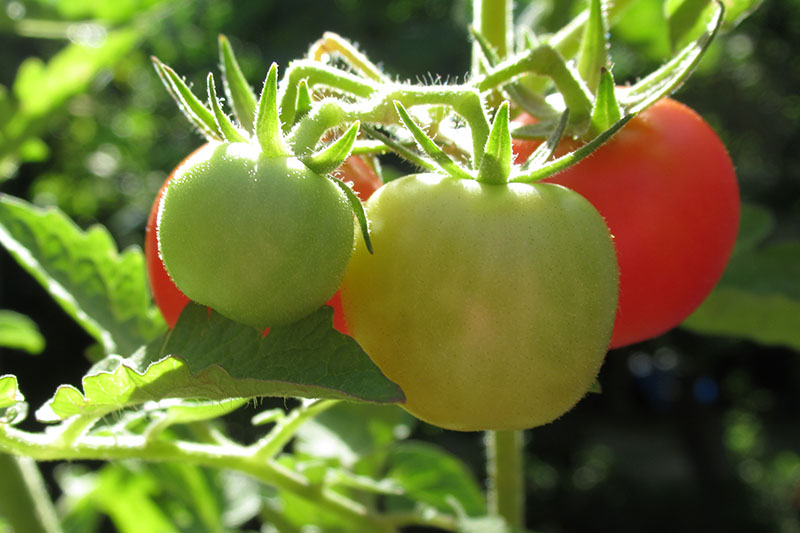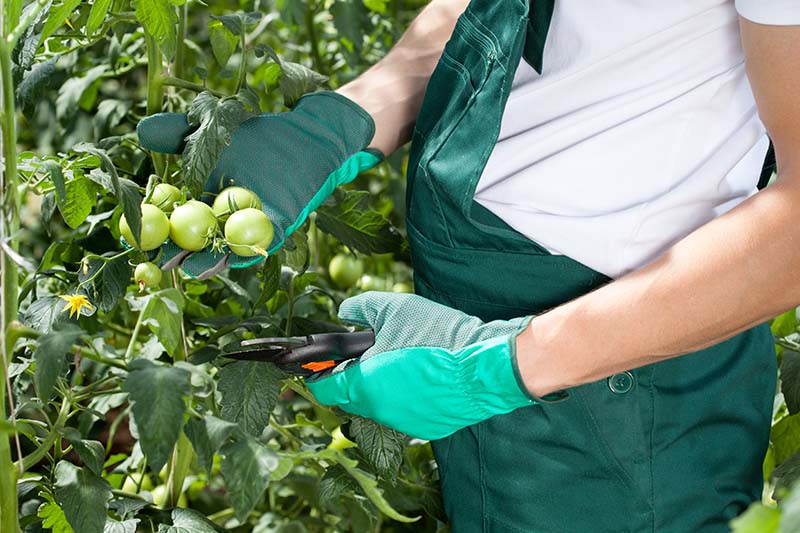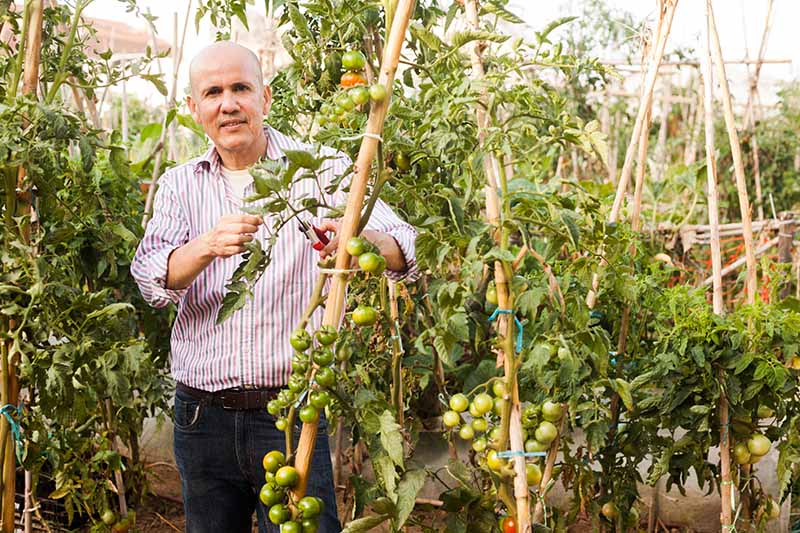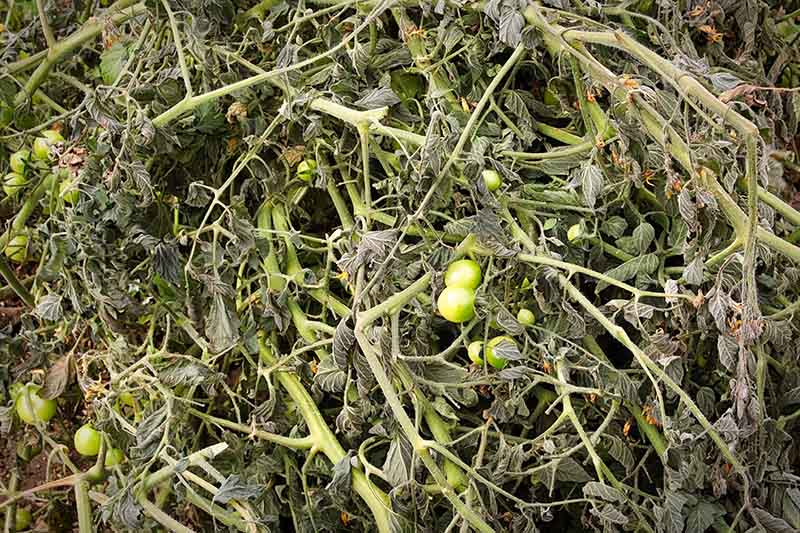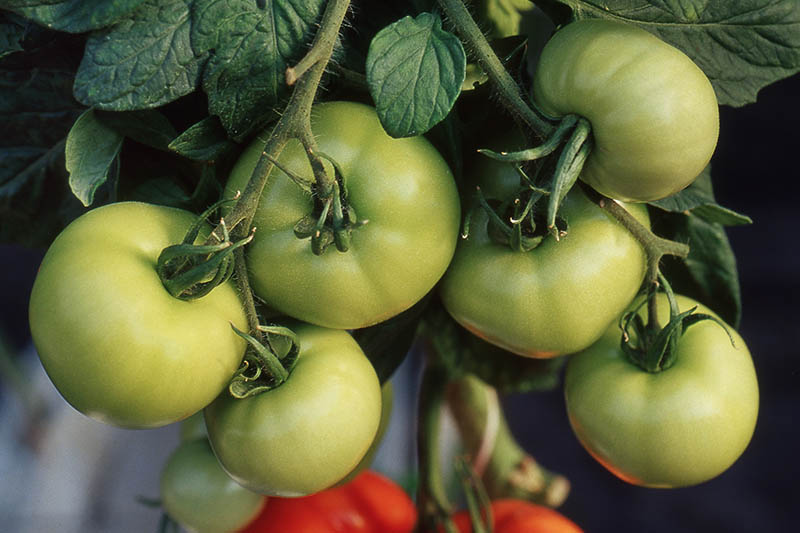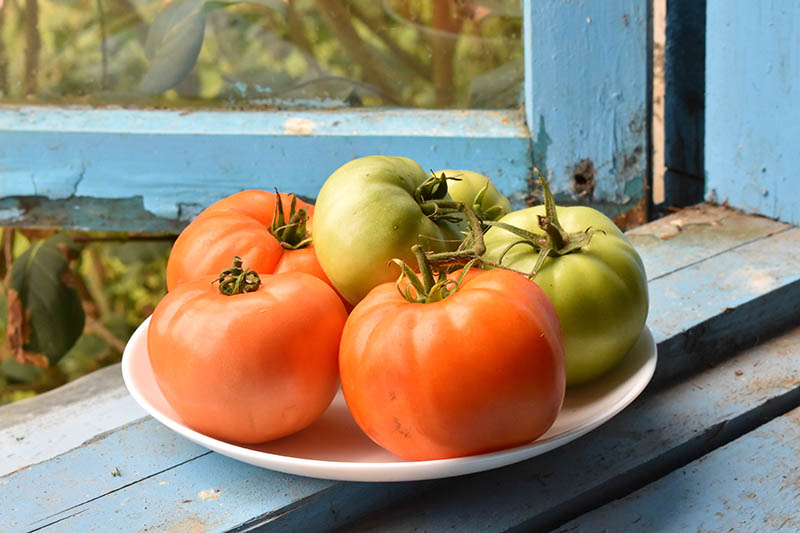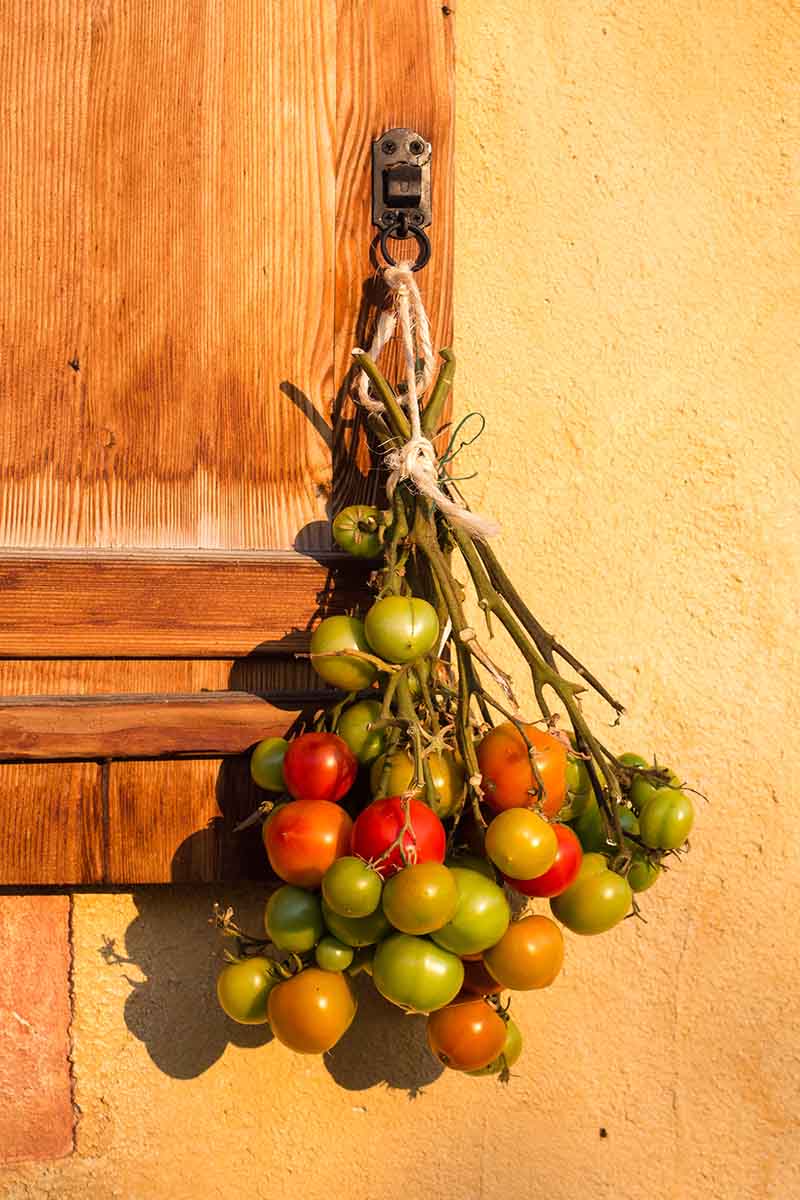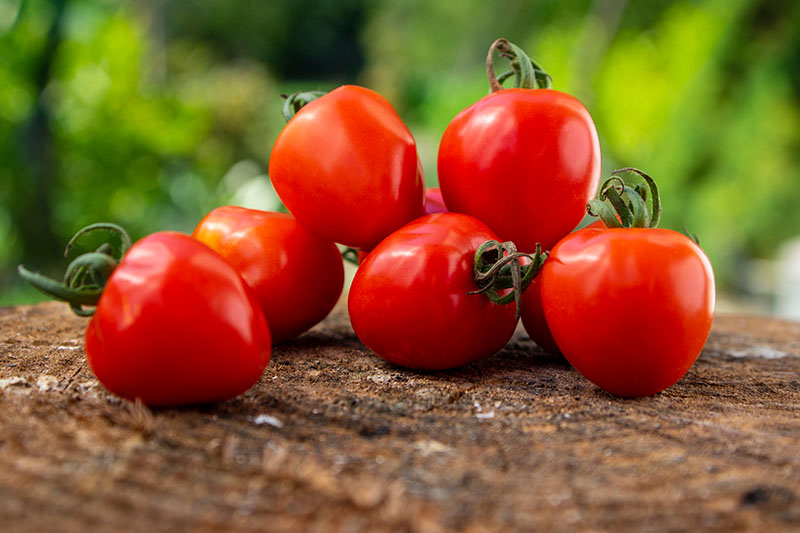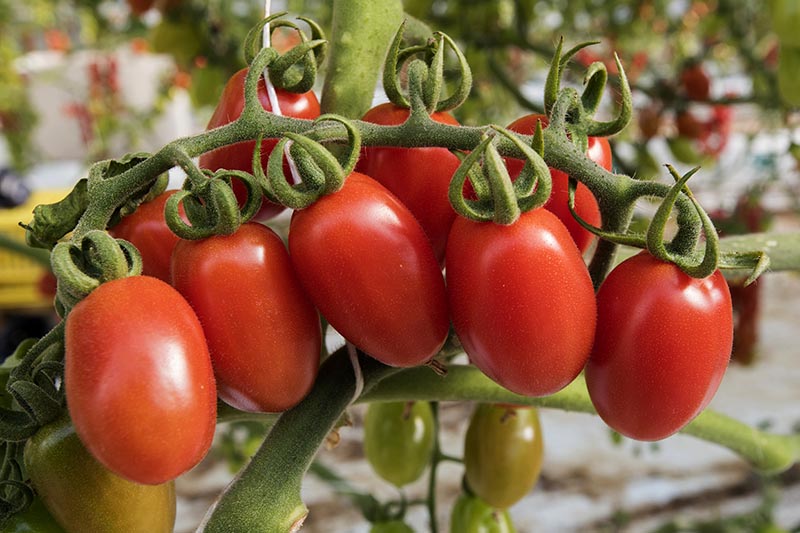And yet, I know that even experienced gardeners have times when their plants are nearing that all-important harvest date and the fruit is still hard and green. At any time in the growing season, but especially if a killing frost is bearing down, your stress increases by the minute. What’s a gardener to do? I’m going to help you out here, with several ways to encourage tomatoes to turn red on the vine. We link to vendors to help you find relevant products. If you buy from one of our links, we may earn a commission. But there are also solutions for those in the “Ack! The tomatoes are green and autumn’s arriving” camp. And I’ll encourage you to keep trying even if you have to pick every last green fruit, even the cherry ones, and try to ripen them indoors.
After all, red tomatoes are a delight for the eyes, and a treat for the palate. It would be awful to tend your plants for the 70-100 days most take to produce ripe fruit and then come up short at the end of the season. These are the aspects that I’ll cover:
Why Are Ripe Tomatoes Commonly Red?
If your plants are producing fruit that isn’t a vivid crimson, it’s comforting to know that lots of gardeners have that complaint. After all, we all want red tomatoes! But did you ever stop to ask why these fresh tomatoes us home growers find so desirable are red? There’s a scientific explanation, and knowing about it can help you with your own fruits that stay stubbornly green when you want them to be a nice red color.
When the fruits are green, they get this color from chlorophyll. When they progress from maturity to ripening, they produce a naturally-occurring hormone called ethylene. The ethylene initiates the ripening process, triggering the fruit to start turning red and also to soften. As for the timeline on which this occurs, it usually takes a tomato plant about three weeks from transplant to get tall enough to flower, about 12 to 18 inches in height for most cultivars. From there, if all goes well, it usually produces green fruit that grow to maturity in another 20 to 30 days. Once they’re full size, it will take another 20 to 30 days, on average, to ripen and change color from green to yellow to red.
Cherry and grape varieties can ordinarily produce tiny, ripe, red fruit in 25-30 days total from bloom to harvest. If you do the math and that’s not what’s happening in your garden, it’s time to do some more sleuthing and determine why your crops aren’t ripening on the vine.
4 Reasons Your Tomatoes Won’t Ripen on the Vine
As I know from experience on more than one occasion when my vines were stubbornly holding on to hard, green fruit, you can’t take this phenomenon personally.
Instead, survey your plants and garden to see if one of these four factors might be affecting their ability to ripen into a luscious red:
1. Temperatures Are Too Warm
If your tomatoes seem permanently paused on green and it’s still warm, heat could be the cause. It’s hard to believe this about such easy-to-grow garden vegetables, but they can be a bit temperature sensitive. Along with ethylene, temperature dictates when the pigment will begin to change.
The optimal temperature for tomatoes to turn red is 68-77°F. A little warmer is okay, but when temperatures exceed 85-90°F, the ripening process grinds to a halt, or at least slows down. If the temperature is too warm, your fruits may look either greenish orange or pale green on the vine, to the point of being almost white. But alas, not red. Fortunately, there is good news: If it’s just too hot for the pigments to develop, you will likely have plenty of time in the growing season left to cope with the slowdown.
2. Temperatures Are Too Cool
On the flip side, cooler weather can also put a stop to those desired changes that will turn your crops a rosy shade. Again, you’re seeking that optimal 68-77°F range for them to ripen to a sporty red hue.
If the temps dip to 55°F, add at least a week or maybe two to the average time it would take the fruit to ripen if it were 65°F out, based on your seed packets or plant tags. What to do if the weather should get cooler still? If your area sustains nighttime temps lower than 50°F paired with daytime temps under 60°F, and this lasts for two weeks or more, the transformation to that lovely red shade that you’re going for will halt completely. Nor will your plants set fruit to ripen when the air is colder than 50°F. You might get some green fruits if your plants are trying to set fruit in 50-55°F weather, but count on them to also develop odd shapes and soft spots.
The solution to getting those with green fruits through a chilly snap is straightforward: Protect the plants with row cover, an old bed sheet, or even a plastic tarp. Once a tomato plant is hit with freezing temperatures, you can banish any hope for the green fruits to come to harvest, and for the plants themselves. Unfortunately, you won’t be able to salvage any fruit at that point.
But if there’s no end in sight to the chilly temps, or reliable sources are predicting frost, you can still triage the fruit that’s already on your plants. You may be able to bring any that have at least begun to show signs of growing softer or changing color inside to ripen. A little later in this guide, I’ll provide some instructions for saving green tomatoes before a freeze, and turning them red indoors. But that’s your last resort. Before this takes place, review the possible reasons why your fruits aren’t ripening on the vine, and try to solve these issues before frost arrives.
3. Wrong Variety for Your Growing Season
If you’re growing what you hoped would be juicy red tomatoes but they’re still green, and frost is approaching, you may have chosen an inappropriate variety for your area.
When you live in a place where there’s a short growing season, it’s important to select short-season cultivars so the green fruit has time to grow to its full size and turn red before temperatures drop below 50°F. A few of the best short-season varieties include ‘Early Girl,’ which produces ripe, red fruit about 50 days after transplant, and ‘Juliet,’ a red grape cultivar that’s ready to harvest about 60 days from transplant.
Sometimes, even a reliable local nursery will stock seedlings of a variety that won’t produce ripe fruit reliably before the first frost arrives in your area. Make sure to research how long your chosen cultivars will take to mature before you buy transplants, and do the same if you’re going to order seeds or plants from a reputable seller.
4. Stressed or Overgrown Vines
Like every living thing, tomato plants only have so much energy. If they’re using too much to grow leaves and flowers, they may not have any energy left to turn green fruit red.
To make sure this doesn’t happen on your vines, some timely pruning is in order six weeks before the first expected frost in your area. Use scissors or shears to trim your vines, cutting them back to the point where the stems are holding mature green fruit. This aids ripening in two ways:
It discourages the plant from blossoming further, which takes away valuable energy. It improves airflow, which can prevent fruits and plants from being infected with disease.
You can also try to encourage those green fruits to turn red by pruning your plants’ roots.
Doing this is pretty straightforward: You use a shovel to cut the roots below the soil, aiming about one foot away from the main stem of each plant. Slice about 6 inches into the soil in four or five spots around the plant. This should sever the roots in those spots, which can prevent the plant from growing taller and blossoming, and instead turn its energies to ripening the existing fruit.
When You Should Compost Green Tomatoes
This is one of the many reasons why I love growing my own fruits and vegetables. So much good can come from this, even from produce that doesn’t make it to harvest. Green tomatoes are a great example. If you’ve chosen a variety that won’t ripen on the vine in time, or an unexpected bout of chilly weather strikes late in the growing season, you can still get some value from the green fruit by adding them to your compost pile.
No, it’s not as satisfying as sitting down to a harvest of vine-ripened, homegrown produce. But it’s comforting to know that at least your efforts still yielded some nutritious compost components. Where do you draw the line between identifying green tomatoes on the vine that can be ripened indoors and those you should add to the compost? Any green ones that are still hard should be tossed onto the pile or into the bin. You only want to spend the time and energy on indoor ripening if it’s what us gardeners call “mature green.” Look for a glossy green surface, and squeeze the tomato gently. It should be at least a little soft and maybe streaked with a bit of yellow, indicating that ripening has begun on the vine.
If they are hard, with a flat, matte green color, it’s time to give up and use them to enrich the compost for next year’s planting. This goes double for green grape or cherry varieties that won’t ripen on the vine. No amount of nurturing indoors will make them turn red, and they’re lots of trouble to pick individually and bring indoors. And skip the heroic measures for any unripe fruits that are marred or misshapen. They’ll most likely shrivel indoors, and would do far better in the compost. If you don’t have a compost pile or bin at the ready, tomatoes that won’t turn red offer the perfect opportunity to start this earth-friendly habit. Read our handy guide on composting to learn more about all the things you can add at the end of the vegetable growing season.
How to Ripen Green Tomatoes Indoors
I’m not gonna lie. When you have to resort to trying to make your unripe harvest turn red indoors, you’re not going to get the same great taste as you would with vine-ripened homegrown fruit. For one thing, while you can make them ripen a bit indoors, you can’t make it produce the sugars that make homegrown tomatoes taste so great. You can encourage your green harvest to produce more ethylene, but that doesn’t produce sugar.
Still, it’s worth a shot if you have “mature green” tomatoes on your vines. Don’t expect luscious, dripping slicers, but do count on red fruit that still tastes much better than the commercial variety. Instead of eating them in, say, a caprese salad, you’ll probably be happier using them in homemade salsa or on tacos, or simmered into soups. Are you growing your plants in containers? The simplest way to try to turn those red is to bring the whole potted plant indoors, where it’s warmer. If you’ve got the space and the muscle, you can also uproot entire vines full of mature green fruit and hang them upside down from rafters in the garage or basement until fruits are red and ripe.
Make sure some of the roots are still attached, and hang the vines in an area that’s well lit but not in direct sunlight. Wherever you move your potted or uprooted plants, make sure the temperature there is consistently in the 50-70°F range. You can also pick them individually to ripen indoors. If you set them on a countertop, they’ll eventually produce enough ethylene to turn red and to soften. If you get impatient, you can also set them in a bag with a ripe tomato to speed up their ethylene production. If you add a slice of banana or apple to the mix, it will give off ethylene gas and speed the ripening process even more.
You’ll have to be vigilant, though, and remove each one that turns red as it ripens. Otherwise, you’ll end up with rotted fruit oozing over the still-hard green fruit. (I’ve seen this with my own eyes.)
Love Is Like a Red, Red Tomato
When you make all that effort to grow your own luscious tomatoes, it’s only fair that they be a delicious, eye-appealing red at harvest time. If you didn’t have time for even a last-minute effort to make your crop turn red on the vine, remember, there’s always next year.
It’s never too early to start thinking about the best selections for red tomatoes in your area, or to start preparing your garden for a red harvest when next year’s plants mature. If you’ve got a story about your own stubborn crop refusing to ripen on the vine, please share it in the comments section below, along with any questions you may have. To learn more about growing tomatoes in your garden, you’ll find even more helpful info here:
Grow Tomatoes from Seed in 6 Easy Steps 15 of the Best Canning Tomatoes You Should Grow How to Grow and Care for Tomatoes in Your Garden Tips for Growing Roma Tomatoes
© Ask the Experts, LLC. ALL RIGHTS RESERVED. See our TOS for more details. Uncredited photos: Shutterstock.
